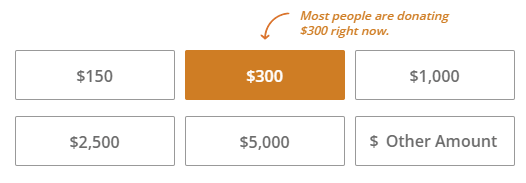3 Tips to Use Donor Data to Improve Nonprofit Storytelling

Throughout the course of managing your nonprofit’s donors, you likely gather a lot of information about them. Your donor data is a treasure trove of insights about the individuals who power your nonprofit’s mission.
In addition to supporting your fundraising, relationship-building, and prospect research efforts, did you know donor data can also play a supporting role in nonprofit storytelling? Donor data can help you tell more impactful stories and tailor your storytelling to each donor’s preferences.
In this guide, we’ll explore these three tips for using donor data to enhance your storytelling efforts:
- Incorporate data into your impact stories.
- Use donor data to enhance social proof.
- Develop donor segments for tailored outreach.
Data can enhance your storytelling in two primary ways: it can support your narratives with credible facts and help you choose the right ways to tell stories based on donors’ interests. These tips will help you make the most of these benefits to tell stories that inspire your audience to get more deeply involved in your mission.
1. Incorporate data into your impact stories.
Data can help your audience understand complex concepts or provide context for trends and patterns. However, data points on their own aren’t the most engaging addition to your marketing efforts.
Marketing research has found that stories are much more memorable than facts alone (some figures say stories are 22 times more likely to be remembered). Stories include rich details and emotional moments that provide context for data.
That’s why you should seek to intertwine narrative storytelling with hard facts and data. Doing so will help you tell stories that not only have an impact but also stick with donors well after they hear them.
Enhance your data storytelling by using data to:
-
- Show results and progress made over time. For example, perhaps your nonprofit has expanded its geographic reach over the years and you want to tell a story about your outreach into new communities. An interactive map and timeline can illustrate this progress and show donors the depth of your impact.
- Explain trends and patterns. Let’s say you’ve noticed a new trend at your nonprofit of more volunteers getting involved with peer-to-peer fundraising. By sharing data about how many volunteers participate in fundraising, you can illustrate this trend and inspire more volunteers to get involved.
- Break down complex topics. Your nonprofit’s mission could involve complex topics like research or complicated legal scenarios. Using data, especially infographics, is an effective way to make these concepts easier to understand.
Incorporate these data storytelling examples into nonprofit marketing materials, from your annual report to your monthly newsletter. Make your stories more engaging by combining written text, data visualizations, and images that bring your tales to life and make them even more memorable.
2. Use donor data to enhance social proof.
Donor data can help you tell more compelling stories to potential donors by leveraging social proof. Social proof is the concept that people will imitate the behaviors of others in a given situation.
Incorporating social proof into your nonprofit’s marketing and storytelling efforts can help you recruit new supporters and solidify relationships with existing donors. Here are a few ways you can increase donor engagement using data-driven social proof:
-
- Drive conversions on your online donation form. Including data on your donation page can help you increase online giving. For example, you could reference past donation trends to offer suggested donation amounts and highlight the most popular donation amount. This can influence new donors to choose that amount to align with established norms. Check out an example of this on the CARE online donation page:

- Increase involvement in giving programs. Supporters may be interested in joining certain giving programs at your organization, like your monthly giving program, but need extra encouragement to get involved. Compile data about current donors to give prospective supporters the additional motivation they need. For instance, you could include a note on your online giving page that says 70% of all your nonprofit’s donors are members of your monthly giving program.
- Recruit more advocates. Social proof can also help you recruit more supporters to advocate for your mission, whether through peer-to-peer fundraising, word-of-mouth promotions, or full-fledged advocacy campaigns. For example, you could share that 97% of current donors say they feel more connected to their fellow community members after joining your advocacy program.
Ultimately, most people just want to feel part of something bigger than themselves, and that motivates many individuals to support nonprofits over the long term. You can inspire greater participation in your programs by enhancing the feeling of community among supporters and using data to demonstrate the power of your donor base.
3. Develop donor segments for tailored outreach.
In addition to enhancing your stories themselves, the other major way that donor data can support your storytelling efforts is by helping you develop tailored messaging approaches that fit each donor’s unique needs and interests.
Naturally, different types of stories will resonate with different segments. Determine which stories will resonate with each audience by using donor data to group audience members in a process called segmentation. According to Bloomerang’s donor segmentation guide, this process involves “separating your nonprofit supporters into groups based on common qualities and characteristics they share.”
To segment donors, you’ll use your nonprofit’s CRM database to filter donors based on certain criteria and create dedicated groups based on the patterns that emerge. For example, segments can be based on:
- How recently donors started supporting your nonprofit (whether new donors, established donors, or long-time donors)
- How frequently donors give (annually, quarterly, monthly, sporadically, etc.)
- How much donors give (this could include major, mid-level, and small donors)
- What motivates donors to give (whether past involvement as a beneficiary, participation as a volunteer, or a strong personal conviction for your mission)
After creating these segments, strategize ways to reach out to each group using storytelling techniques that resonate with them. Let’s say you’re creating a storytelling and marketing strategy for an upcoming crowdfunding campaign. You could segment donors based on the reason they give to your nonprofit to send each group stories that resonate with their motivations.
For instance, donors who give because they’re former beneficiaries would likely be interested in stories about other beneficiaries who you’ve been able to support recently. Donors who also volunteer may respond positively to stories about how donations keep your volunteer program stocked with the resources it needs to be successful.
Donors will be more likely to give to your upcoming campaign when you make an effort to connect with them using messages that resonate with their values and life experiences.
Although it may seem like cold, hard data and the emotional beats of nonprofit storytelling would be odds, the truth is they can work together to enhance your organization’s overall marketing approach. Data can help you understand your audience as individuals to craft stories that speak to them on multiple levels. Ultimately, this allows you to grow stronger bonds with existing donors and expand your reach to new audiences.



